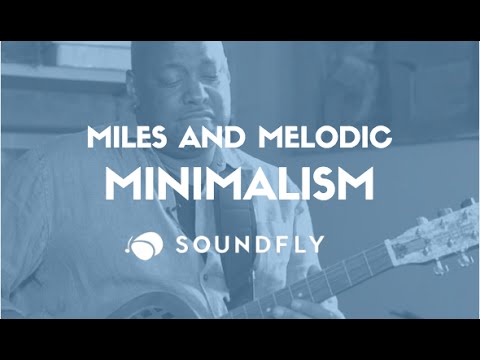
Miles Davis is by far even more economical than Coltrane.
Almost like a Japanese parchment painting, where you just take the ink and that’s it, man.
It’s there and that’s it.
In “Freddie Freeloader”, Miles does something really beautiful. He gives me a melody of 2 notes.
See, he’s doing the 12 bar blues. It’s the 12 bar blues.
But he does something here:
he cadences on Ab7.
Ab7? Hey…
what key am I in?
Now there are 2 wonderful things that allow us here, as improvisors, to play around.
The first thing is this 6 to 5 resolution.
There’s no resolution to the 1 or to the 3.
It’s 6 to 5. Which means that my melodic gravity is not on 1 or 3. But in the upper part of the scale.
It’s up here.
And if I decide that it’s up here,
it has a whole other flavor. It’s not jazz, it’s not blues. It almost sounds Middle Eastern.
Which then allows me not only to expand on the melodic invention
but the rhythmnic invention, the stylistic invention.
All because basically what Miles has given us is a thematic palette
that does not sit in the stable interval, which is 1 and 3.
Now in all blues, he gives us:
Miles takes that basic pattern,
slows it down,
and uses it as the undercurrent.
And he lets us rock in 6/8 and then he gives us a melody.
Again, the melody is 1 note.
It goes up, and it comes down. What goes up must come down.
This melodic line, starting on the 3rd:
and he hits it again. He hits it a third time.
He’s in the upper part of the pentachord.
He goes to the 4 chord, but he lands on the A, which is the 13th.
And he moves up and down.
See, what goes up must come down. It’s very interesting.
OOH, that 7th! That dissonant. Lets us move.
What’s happening in this melody, even though it’s incredibly simple, is that it keeps moving
it keeps on wanting to go somewhere.
And that of course, then, when we begin to improvise, does the exact same thing.
Because now, we have something to move around with.
You see, I’m moving around
but I’m avoiding the G.
Why am I avoiding that G? Because the G is the tonic
and if I sit and I linger on that G, I have very few places to go.
There’s something else that Miles does that I love
is when he goes to the 5 chord, he doesn’t go down to the 4 chord, which of course would be traditional blues.
He goes… ah, he goes up to the flat 6, and then back to 5 and then back to 1.
And then he focuses there on 1, but his melody has landed on the A, which is the 9th.
It still isn’t settling.
And of course, as the improvisor, the less settled, the more I have to say.



